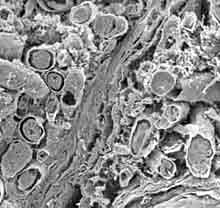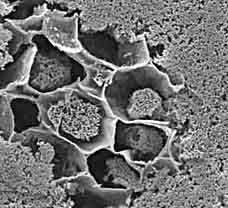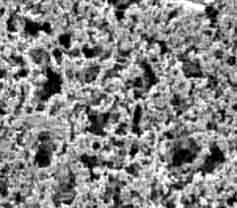|
Soybeans, native of northern China, have been used as foods in Asia for many centuries, apparently in conjunction with the emphasis of buddhism on vegetarianism. In North America, they were unknown until the 19th century, more precisely until 1854, when Commodore Matthew Perry's expedition brought them from China. Nowadays, however, they are the sesond largest cash crop in the United States and they are grown in increasing quantities in Canada. Unlike other legumes, the beans store energy in the form of oil (about 20%) rather than starch. The oil is highly unsaturated and that means, very unstable. Hydrogenation is used to convert it into margarine. However, the protein content in the beans, at about 40% almost twice as high as in other legumes and five times as high as in corn, initially made the soy meal a valuable stock feed.
It is the protein quality of the soybeans with an excellent amino acid balance which has also made it an attractive human food source. Nowadays, soybeans are processed into a great variety of foods. Some soy foods are even called white meat.
There are, however, concerns, that soy should not be considered as a substitute for animal products like meat or milk. Soybean lacks vital sulfur-containing amino acids cystine and methionine. Thus it is recommended to fortify the soy protein diet with cystine-rich meat, eggs, or dairy products. However, according to a University of Illinois article, soy protein is a complete source of adequate quantities of all 9 essential amino acids which are necessary for the building and maintenance of human body tissues. It does not lack sulfur-containing amino acids cysteine and methionine, but is limiting, not lacking, in methionine and cysteine (not an essential amino acid for adults).
Back to the "concerns", unfermented soy protein foods are known to contain trypsin inhibitors and hemagglutinin which are growth depressing substances. They are deactivated during the process of fermentation but in precipitated products, enzyme inhibitors concentrate in the soaking liquid rather than in the curd. Unfermented soy contains phytates and phytoestrogens which are also of concern. In Dr. Michael Lam's article, modern processed soy products, including soy burgers and soy cheese are mentioned as not the same as the traditional Asian soy. They are by and large unfermented and include tofu and soy proteins. He has stated that the total caloric intake from soy in the Chinese diet is only 1.5%.
Only fermented soy-based foods such as miso, natto, and tempeh are safe to eat.
Fermented soybeans have a strong smell. Aspergillus oryzae is a filamentous fungus in miso, Rhizopus oligosporus is a fungus used to produce tempeh, but bacteria (Bacillus natto ferment soybeans into natto. There is also another advice how to make natto at home.
Readers unfamiliar with unusual terms associated with soya and related foods may use glossary 1 or glossary 2.
 |
 |
 |
Miso
(Image width: 305 µm) |
Firm tofu
(Image width: 70 µm) |
Firm tofu
(Image width: 10.8 µm) |
The micrographs above show fungal hyphae of Aspergillus oryzae in miso (left), soybean cell wall fragments in firm tofu (middle, low magnification), and the protein matrix of firm tofu (right, high magnification). How to calculate the magnification of the subjects from the image width in a print or on a monitor? Please visit the true magnification.
Soymilk may easily be made into soy yogurt by inoculating it with lactic acid bacteria (or by stirring a teaspoon of dairy yogurt per 0.5 L of soymilk) and keeping the mixture warm. Stachyose, the sugar present in soymilk, is metabolised by the bacteria which in cow milk metabolize lactose. Consequently, the soy proteins coagulate and form a matrix similar to that of cow milk yogurt, except that it is finer. Residual cellular wall fragments may occasionally be found by microscopy in soy yogurt as they have been shown in tofu above. Their incidence depends on the purity of the soymilk used. Soy yogurt made without any additives is somewhat more brittle than cow milk yogurt. All 3 images were obtained by scanning electron microscopy (SEM) using the same procedure as for yogurt.
***
Soy proteins have various functional properties useful to foods and may be used as food ingredients. They have been textured to simulate bacon, chicken meat, and seafood. Soy yogurt simulates a milk-based yogurt and tofu resembles unripened cheese in some applications. Soy proteins have also been used to replace cereal proteins.
Proteins may be extracted from soybeans under alkaline conditions. The protein mixture consists of so-called 2S, 7S, 11S, and 15S globulins. These names relate to the sedimentation rates of soy proteins in an ultracentrifuge. Their concentrations vary widely in soybeans of different cultivars grown under various conditions:
|
Fraction: |
Proteins: |
%: |
|
2S |
alpha-conglycinin, trypsin inhibitor |
8-22 |
|
7S |
beta- and gamma-conglycinin, lipoxygenase, beta-amylase |
35-37 |
|
11S |
glycinin, lipoxygenase, beta-amylase |
31-50 |
|
15S |
probably aggregated 11S |
5-11 |
Glycinin and beta-conglycinin are the most important proteins for food applications. Soy proteins bind calcium ions (Ca++), especially when first treated with alkali. Other divalent cations such as magnesium (Mg), zinc (Zn), and iron (Fe) are also bound. Glycinin binds more Ca than beta-conglycinin.
Heating denatures soy proteins: beta-conglycinin is denaturated at 75°C and glycinin is denaturated at 90°C. In a mixture, they interact on heating with each other.
For information on soy proteins in greater detail, please see papers in scientific journals such as Journal of the American Oil Chemists' Society (JAOCS), Journal of Food Science (JFS), Cereal Chemistry (CC), Food Structure (use the Edit-Find function of your browser), etc., particularly:
- Physico-chemical aspects of soy proteins structure formation. A.-M. Hermansson, Journal of Texture Studies 9:33, 1978
- Functional properties of soy proteins. J. E. Kinsella, JAOCS 56:242, 1979
- The role of soybeans in food systems. R. Bressani, JAOCS 58:392, 1981
- Soy protein products in cereal grain foods. D. K. Dubois, W. J. Hoover, JAOCS 58:343
- Current aspects of soy protein fractionation and nomenclature. J. R. Brooks, C. V. Morr, JAOCS 62:1347, 1985
- Current status of soy protein functionality in food systems. C. V. Morr, JAOCS 67:265, 1990
- Recent progress of soybean protein foods: chemistry, technology, and nutrition. D. Fukushima. Food Review International 7:323, 1991.
|


